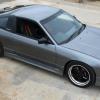Te37 Sl Taking Pre-orders Now
Announcements
-
Similar Content
-
Latest Posts
-
I'm honestly not sure. I wired it into the OEM ECU and my pinning the ECU and making the plug is not as perfect as the OEM would otherwise be. This is via the Torque app for ODBII. You can set an alarm, but you can't set a timed alarm. It would be nice to set the alarm threshold for being under X psi for 0.2 seconds or something like that to filter this out. I also noticed the OEM R34 gauge has very specific intervals it sets itself to. I.e 1-2-3-4 bar, and it rounds down. So if you say have 27psi oil pressure hot, the OEM gauge will read 1 bar at idle. (GM incredibly specify 7psi per 1000 RPM so 1 bar is double what is 'needed') This terrifying notion is what lead me to get 3 oil pressure sensors and gauges
-
I can appreciate those as nice cars but I'm more of an Audi fan, did almost buy an RS5 but settled for the cheapo R33 Haha that is a wild idea, how about a banged up R33 and a case of beer? Mates rates? 😁
-
By Dose Pipe Sutututu · Posted
Win win! Here's a wild idea @Yeetus, come to my doorstep with either $60K or a F80 M3 and take my car away from me. It could rev to 9000rpm but I would recommend putting in beehive springs. -
And you can then legally not use your indicator too! 😛
-
So, Barra Turbo, with a fake RB25 and Nissan badging on it to confuse all? 😛
-










Recommended Posts